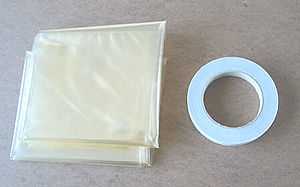Window insulation film
Window insulation film is a plastic film which can be applied to glass windows to reduce heat transfer. There are two types in common use designed to reduce heat flow via radiation and convection respectively.
Solar control film
This works by reflecting the infra-red component of solar energy (often 700W/sq M) and absorbing the UV component. Some films are also silvered or tinted to reduce visible light.
Typical absorption for a silvered film is 65% for visible and infra red with 99% for UV. This type of film sticks directly onto the glass.
Convection control film

This film is attached to the window frame using double-sided pressure-sensitive tape. The effect is to create a double-glazed system with a still air layer about 0.5 inches thick between the film and the glass. This restricts the convective air flow which efficiently transfers heat onto the inside glass surface. The reduced heat flow also can prevent condensation [1][2][3] which is triggered when the temperature of the inside surface falls below the dew point. Assuming an outside temperature of 0 °C with wind velocity 15 mph and inside temperature 20 °C condensation occurs at only 30%RH relative humidity with a single-glazed system compared with 60%RH for a double-glazed system.[4] Condensation also transfers an additional 2200 J/ml, which is significant.
The film is a heat-shrink plastic which allows a hair dryer to be used to remove creases and improve optical clarity. Since the thermal conductivity of air (0.024 W/mK) is much lower than glass (0.96 W/mK)[5] the heat flow via conduction could be theoretically reduced by 97.5% though this is limited in practice by slow air movement in the convective cell formed between the film and the glass.
However, a typical window insulation film kit will not prevent convection unless the frame is less than 1 inch from the glazing. The top sash of a typical double hung window is 1-2 inches behind the lower sash which is 2-3 inches behind the window frame. This is too far to eliminate convection. In these situations, the kits work by reducing infiltration not convection, and are similar to interior 'storm windows.' The ideal distance for 2 sheets of glazing is about .5-.75 inches (refer to insulated glazing).
Applications
Solar control film is an effective way to control excessive sunshine during the summer months.
Convection control film is often used in winter when the outgoing heat flow is more important, especially for single-glazed windows where the temperature difference is often sufficient to cause condensation.
See also
- Shrink film
References
- ↑ Condensation on Inside Window Surfaces CANADIAN BUILDING DIGEST, Originally published April 1960, A. G. Wilson
- ↑ Questions about windows and condensation National Fenestration Rating Council
- ↑ Strategies to Prevent Condensation in Buildings Eduardo de Oliveira Fernandes, Vítor Leal and Francisco Craveiro IDMEC and DEMEGI, Faculty of Engineering, University of Porto Porto
- ↑ Condensation Potential Chart RLC Engineering, LLC.
- ↑ Thermal conductivity of common materials Engineering toolbox